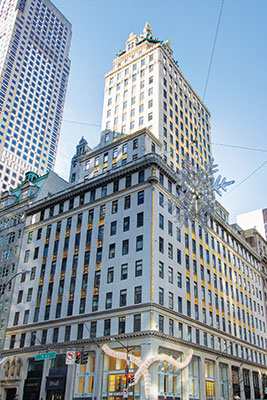Large Manhattan Class A office building sales are on fire.
In a rebound following several slow years, 12 towers worth nearly $9 billion combined sold or went into contract in the first quarter of 2015 alone, far outpacing the rate for the past four years. In comparison, from 2010 to 2014, between 14 and 16 office skyscrapers worth a combined $4.7 billion to $10.6 billion sold each year, an analysis of data from Real Capital Analytics showed.
Among the most notable sales so far this year was 1095 Sixth Avenue, for $2.2 billion to a joint venture between Ivanhoe Cambridge and Callahan Capital Partners, and 730 Fifth Avenue, in contract for $1.75 billion to a partnership between Jeff Sutton and General Growth Partners.
The accelerated pace of transactions reflects rising rental rates, easier lending and eager buyers.
Like any commodity, high demand and limited supply keeps prices high. There are fewer than 250 large Class A office buildings in Manhattan with 450,000 square feet or more, according to a review of data from CoStar Group.
And even as developers build more office towers in Lower Manhattan and Hudson Yards, older properties are being converted to residential use, including 550 Madison Avenue in the Plaza District, and a large portion of the Woolworth Building Downtown.
To get a handle on the universe of potential properties for sale, The Real Deal took a look at scores of buildings and, with input from real estate insiders, estimated nearly 50 held by owners who are likely to sell, including SL Green Realty, GGP and David Werner.
Among those potentially on the block are Rockwood Capital’s 636,000-square-foot 2 Grand Central at 140 East 45th Street and EDGE Fund Advisors 907,000-square-foot 1540 Broadway in Times Square.
The remaining 200 or so properties are owned by landlords who these insiders believe intend to hold on to the assets for a decade or more. For example, Rudin Management is considered unlikely to sell 345 Park Avenue or 3 Times Square, and Boston Properties is expected to hang on to its controlling stake in the General Motors Building and 601 Lexington Avenue, for some time.
Some see an increase in owners considered long-term holders.

The Crown Building at at 730 Fifth Avenue
“For pension funds and foreign investors, the likelihood is that they have a longer hold period than private equity or an entrepreneurial owner,” said Eric Anton, a senior managing director at the brokerage HFF.
Stephen Shapiro, a senior vice president at JLL, said some of the large Chinese firms snapping up NYC properties plan to hold their newly acquired assets for decades.
Recent Class A purchases by Chinese firms include 1 Chase Manhattan Plaza, which Fosun International purchased for $725 million, and the office portion of 717 Fifth Avenue, in contract to sell to the Anbang Insurance Group for an estimated $400 million to $500 million.
But Robert Knakal, chairman of New York investment sales at Cushman & Wakefield, noted that changing circumstances can alter even seemingly firm plans. He recalled another rush of foreign investment in the 1980s that was supposed to last for a generation, driven by the Japanese, which ended in the 1990s with a global recession.
“When the Japanese bought, they were considered long-term holders who own property for hundreds of years,” he said. But today, the Japanese own just a few of the Manhattan buildings bought in the 80s, Knakal said.
Some of the city’s smart money, in fact, is looking to be a net seller.
SL Green, Manhattan’s largest office landlord, said last fall that it expects to sell $600 million worth of office buildings this year in New York, while it expects to spend $400 million buying buildings.
Knakal expects more large Class A office product to hit the market this year, and said he will try to convince more owners to let go. One self-proclaimed long-term holder, SJP Properties, said it is getting cold calls to sell.
Last year, the firm sold a 45-percent stake valued at about $630 million in its 1.1 million square foot 11 Times Square to Norges Bank Investment Management, a Norwegian government pension fund.
“We are approached in some cases directly, in others through an intermediary — a broker, an attorney, a banker,” said Jeff Schotz, executive vice president at SJP. Sometimes the caller will offer an enticing capitalization rate, or say they will sign confidentiality agreements, in exchange for looking over the financial documents. But, Schotz said, his firm tends to sell buildings through hired brokers, not “off market.”
The main drivers behind so many interested buyers are rising asking rents, a tight market supply in the face of anticipated office rent growth and foreign demand for “gateway city” assets.
But Schotz said it’s hard to divine when an owner will decide to sell. “What it comes down to,” he said, is “What are their goals with the asset in question?”
